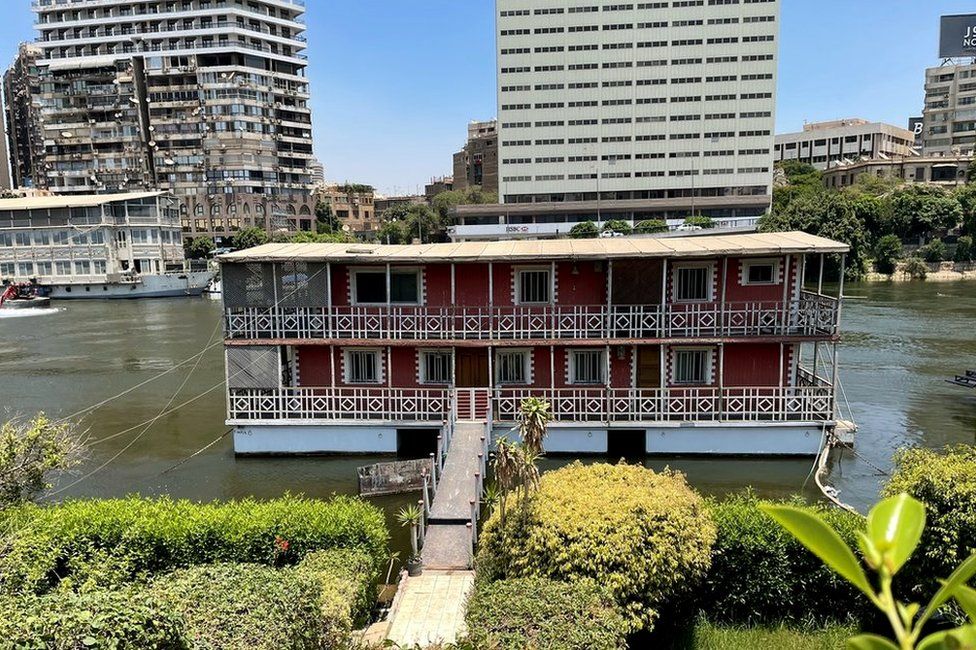Outcry in Egypt as iconic Nile houseboats are destroyed
- Published

For many locals and foreign tourists, the brightly painted wooden houseboats dotted along the River Nile are an iconic part of Cairo's rich cultural and architectural heritage.
But starting this week, the last of those remaining - about 30 in total - are set to be destroyed or removed by the Egyptian authorities as part of what they describe as an effort to beautify the waterfront.
Some of the floating houses, permanently moored on the riverbank, are inhabited by poor residents, while others have been expensively restored. A few have been turned into restaurants, offices and gyms.
"It's a different lifestyle, you are completely immersed in nature. The river is just one metre below you," says the celebrated Egyptian novelist Ahdaf Soueif, whose family home has been slated for destruction.
"The idea of the houseboat has always been connected to something a little bit out of the ordinary," she goes on. "They feel romantic to generations of Egyptians and Arabs."
From her veranda, tugs and cranes can be seen circling properties in the centre of the capital. Three homes - two-storey buildings attached to rafts - were removed on Tuesday and towed away. Earlier in the week, others were removed and one of those was smashed up in the process.
On social media, there has been condemnation from ordinary Egyptians of the action against the houseboats, known as "awamat" (Arabic for "floating").
"Not only are these houseboats homes to people who have lived there for decades, but some of them are historic monuments. They are part of our heritage which cannot be erased," wrote Nora Zeid on Twitter.
"Who said it is not part of the beautiful history of Cairo?" tweeted Dakhel Hafy. "When we stand on the Nile and look at the awamat, we should tell stories, novels and legends about them."
Only a few dispute their aesthetic value. Mostafa el-Gafy tweeted that they were "ugly".
The Egyptian government has defended its decision to issue demolition orders, stating that the houseboats were built decades ago without its consent and that their owners failed to obtain the correct permits and licences.
The irrigation ministry says it will continue the campaign to remove homes moored along the river "in clear violation of the law". The minister, Mohammed Abdel Ati, says it is "a clear message to those who transgress on the Nile".
Many residents own their homes but say they have recently made legal challenges over large hikes in official fees for parking the boats and access to the riverbank.
No compensation is being given to people losing their houses.
"I swear to God, I don't know where to go," says Ekhlas Helmy, 87, in despair as she packs up her belongings.
"My sister has got some of my stuff, my brother too, although they are both unhappy with the situation. They told me to throw away my things."
Madame Helmy, as she is called, was born on a houseboat and says she was raised on fish. Later, after her husband died young, she built her own home on the water, living on it for three decades with her dogs, cat and geese.
The history of houseboats on the Nile is long and colourful. The oldest ones dated back to the time of the pharaohs and were designed for long river trips.
Over time, a technique developed of building homes on floating metal containers held together by wooden or metal beams. These were not meant for sailing but to give a panoramic river view.
During Ottoman times, rich Egyptian pashas often took houseboats as fancy second residences using them to entertain guests with music and belly dancers. During World War Two, British forces lived in them.
The awamat have often been associated with secret liaisons and illicit behaviour.
They are featured in many classic Egyptian films and in the work of the Nobel Prize-winning author, Naguib Mahfouz. His 1966 novel, Adrift on the Nile, follows the lives of young intellectuals who gather at night on a houseboat to chat and smoke drugs.
During the mid-20th Century, there were several hundred houseboats in Cairo. However, many were gradually cleared away by the authorities or fell into disrepair.
The houseboats now under threat are clustered in an area known as Kit Kat.
On one side, across the river, are the high-rise tower blocks and costly hotels on the island of Zamalek. On the other side, lies the less well-off neighbourhood of Imbaba.
There has previously been pressure to commercialise this section of waterfront.
In the evening, the edge of the Nile bustles with restaurants, cafes and private sports clubs located along its banks.
Egypt's government recently opened the first section of a new 5km-long (3-mile) walkway along the Cairo corniche, clearing away many small businesses such as felucca sailboat operators.
Development along the riverbanks has opened debates about the future of the city's most popular public space and what defines the unique charms of the capital.
All photos subject to copyright